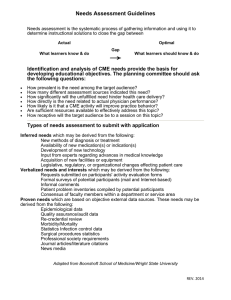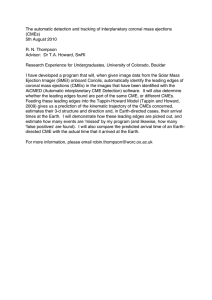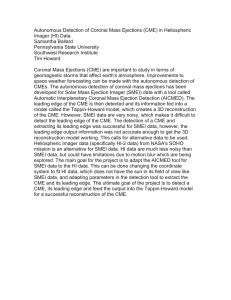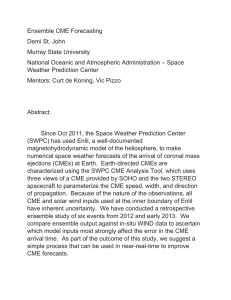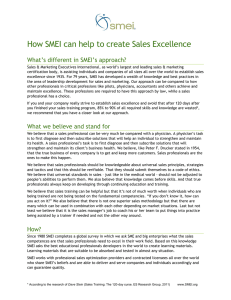Document 12625186
advertisement
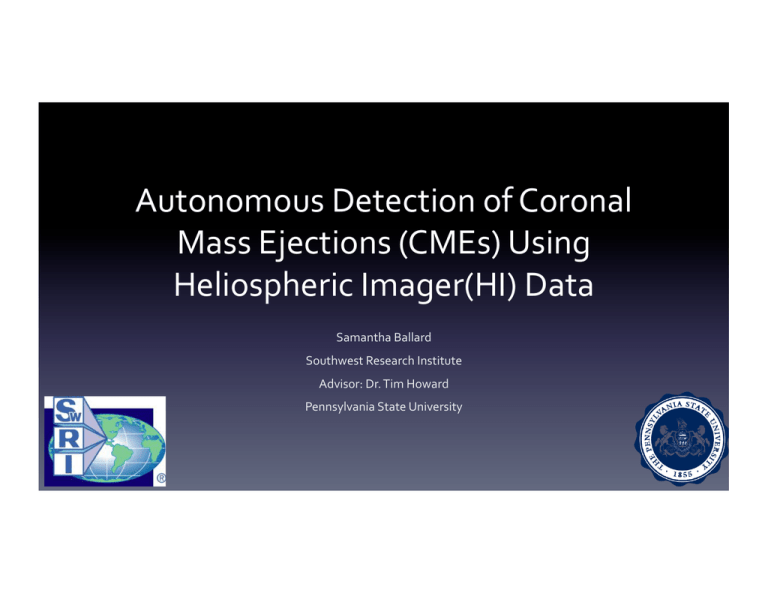
Autonomous Detection of Coronal Mass Ejections (CMEs) Using Heliospheric Imager(HI) Data Samantha Ballard Southwest Research Institute Advisor: Dr. Tim Howard Pennsylvania State University What is a CME? • An eruption of plasma and magnetic field from the sun • Typical speed: 400-­‐1000 km/s • Mass: 1011 – 1012 kg Why Are They Important? • CMEs cause Geomagnetic Storms -­‐ Radiation exposure -­‐ Power grid damage -­‐ Telecommunication disruption • Space Weather Prediction Coronagraph Detection • Detecting CME has been done with coronagraphs • We are using Heliospheric Imagers (HI) • Similar to coronagraphs but have a much wider angle/field of view What Are We Doing? LEADING EDGE • Automatically detect CME and its leading edge using HI • Results fed into Tappin-­‐Howard to form 3D reconstruction of CME • Provides a forecast for CME impact on earth within +/-­‐ 5 hours Prior work Solar Mass Ejection Imager ( SMEI) Data • Onboard Coriolis spacecraft • Now turned off • Noisy • Fisheye or Hammer-­‐Aitoff projection, pieced together view of the sky • Sun in center of field of view CME “Raw” SMEI fisheye Image May 2003 CME Moving from SMEI to HI Heliospheric Imager Data (HI-­‐2A) • onboard NASA's STEREO • Less noise • Sun out of field of view • Can see what CME does in interplantary space • Problem: possible motion blur CME How it Works Summary of Code • Read in images • Form data cube • Parse and smooth Data • Use detection tool AiCMED to identify CME events by applying Hough transform • Detects and records leading edge measurements • Finds noise • Splits CMEs • Convert EA and PA back into pixel coordinates • Plots CME events with noise and leading edge iden:fied • Writes leading edge and noise measurements to text files Output of Leading Edge Measurements Tappin Howard Model • Inputs are CME leading edge measurements and noise gaps • Compares the measured leading edge data with simulated CMEs • All done automa:cally Computer Aided CME Tracking (CACTus) Tool – for Coronagraphs 1. Transform image from Cartesian (x,y) to polar coordinates (r, PA) to map on a new grid 2. Stack collection of images to form a 3D data cube (t, r, PA) 3. Choose a PA through the cube to create a image in (t,r) 4. Result: distance/time plot for each object that crosses a selected PA Problem with CACTus • CACTus can’t apply to HI data • No longer dealing with distance, instead elongation angle • Much larger range of the sky for HI than coronagraphs • Lines will be curved instead of straight • Solution: parsing Parsing and Smoothing Data • Parsing: taking subsections of the data in elongation • Choose a small enough subsection to get a straight line • Smoothing: 5 Methods • Best Method: Scaled Median • Preserves Faint Events Hough Transform 1 2 1) Extracts straight lines from the or Hough space Hough 2) Transforms image to accumulated polar (t,elongation) image 3) Masking and filters applied 4) Transforms back into original coordinates 4 3 Automatic Interplanetary Coronal Mass Ejection Detection (AICMED) Tool • Applies CACTus, parsing and Hough transform processes to SMEI data • Rebins data into PA and EA • Images are stacked into a data cube (t, elongation, position angle) • For each PA slice, the Hough space filtering and masking process • Across a range of subsections of elongations (parsing) • Returns data to Cartesian space (x,y) Success With SMEI Limitations of SMEI • SMEI images are VERY noisy • Noise gaps are crucial for correct detec:on of CMEs • Some CMEs could be hidden behind the noise • Did not work for TH MY CONTRIBUTIONS SMEI Coordinate System • Whole sky projec:on with Sun at center • Posi:on Angle (PA) ranges 0 to 360 degrees • Elonga:on (EA) starts at 0 degrees HI-­‐2A Coordinate System • PA range from 30 to 150 degrees • EA starts around 20 degrees PA • The sun is not in the center of the image EA Transforming to Pixel Coordinates (SMEI) • 4 quadrants x = c cos(A) y = c sin(A) • 1 degree EA = 2 pixels, c = 2 x EA • Dimensions: 560 x 560 Use trigonometry A = P.A. -­‐ 3*Pi/2 x= 280 + c*cos(A) y= 280 + c*sin(A) Transforming to Pixel Coordinates (HI) • 2 quadrants Quadrant 2 c • 1 degree elonga:on = 30 pixels, c = 30 x EA • Dimensions: 1024 x 1024 a Trignometry: A = 90 – PA X = 2700 – c sinA Y = 512 + c cosA Quadrant 3 A b 1) Read in images Check List 2) Form data cube (number of images, EA, PA) 3) Parse and smooth data 4) Use detection tool AiCMED to identify CME events by applying Hough transform 5) Detect and record leading edge measurements 6) Find noise 7) Convert EA and PA back into pixel coordinates 8) Plot CME events with indentified noise and leading edge 9) Write measurements to text files Next Steps • Analyze parsing and Hough transform part of the code • Tweak detection parameters/thresholds if necessary • Figure out why the code isn’t picking out the correct EA and PA for the CME • Identify the noise • Detecting the leading edge SHOULD come easily • Feed into TH model to get 3D reconstruction of CME Acknowledgments • Dr. Tim Howard, SwRI • Dr. James Tappin, RAL • Dr. Marty Snow and Erin Wood, LASP • Max Hampson, LASP • Robin Thompson, University of Oxford • Christina Burns, University of Michigan • Lauren Biddle, University of Arizona • University of Colorado, Boulder • NSF


